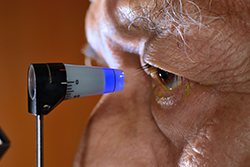 Depending on the type of glaucoma being treated, the surgeon will decide which type of laser treatment is most appropriate for your condition. During a trabeculoplasty, the surgeon directs a laser light beam into the trabecular meshwork of the eye to selectively burn through the meshwork, thus opening it up and allowing aqueous to drain out. Sometimes the laser is used to open up the drainage canals to improve aqueous flow. This procedure is commonly used to treat open-angle glaucoma. Treatments of this type can be repeated if necessary.
Depending on the type of glaucoma being treated, the surgeon will decide which type of laser treatment is most appropriate for your condition. During a trabeculoplasty, the surgeon directs a laser light beam into the trabecular meshwork of the eye to selectively burn through the meshwork, thus opening it up and allowing aqueous to drain out. Sometimes the laser is used to open up the drainage canals to improve aqueous flow. This procedure is commonly used to treat open-angle glaucoma. Treatments of this type can be repeated if necessary.
For treatment of closed angle or narrow-angle glaucoma, a laser peripheral iridotomy (LPI) will often be performed. The surgeon directs the laser to burn a small hole in the iris, the colored part of the eye. This hole allows the iris to move back from the cornea, thus opening the angle between the two and enhancing aqueous flow. The resultant drop in ocular pressure is due to the improved flow out of the eye.
Often, patients with extensive end-stage glaucoma damage do not respond to other glaucoma surgeries. A procedure known as laser cyclophotocoagulation is used to reduce eye pressure in these cases. This laser treatment targets the ciliary body in the eye, the component that produces aqueous fluid.
Often times if the laser therapy does not lower the pressure adequately, the surgeon may recommend conventional glaucoma surgery. Lasers are typically performed in an outpatient setting and patients return home following the surgery. In some instances, patients report a slight stinging sensation during the procedure, but overall the lasers are considered painless. Patients can experience blurred vision and some irritation following the laser. Patients may begin driving and return to work the following day.





